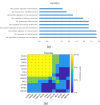Explore the possible influence of Sjogren's syndrome on thyroid cancer: A literature data mining and meta-analysis
- PMID: 39928612
- PMCID: PMC11809879
- DOI: 10.1371/journal.pone.0318747
Explore the possible influence of Sjogren's syndrome on thyroid cancer: A literature data mining and meta-analysis
Abstract
Objectives: To explore the potential influence of Sjogren's syndrome (SS) on thyroid cancer (TC).
Methods: First, a literature data mining (LDM) approach was used to reconstruct functional pathways connecting SS and TC. A meta-analysis was then performed to examine the expression changes of genes mediated by SS using 16 TC case/control expression datasets, with results validated through the TCGA/GTEx dataset. Finally, gene set enrichment analysis (GSEA) and survival analysis using GEPIA2 were conducted on the significant genes.
Results: Our findings indicate that SS may increase the risk of TC by activating 14 TC promoters (PDCD1, NTRK1, LGALS3, CD274, FOXP3, BCL2, CYP1A1, HMGB1, TGFB1, CCL2, PLA2G7, TFF3, LCN2, and CLDN1) and suppressing three TC inhibitors (MIR145, MIR30C1, and EP300). Four molecules (PLA2G7, TFF3, LCN2, and CLDN1) exhibited significant expression changes in TC patients (LFC > 1 or < -1; p < 2.07E-04), which were confirmed in TCGA/GTEx expression analysis. These results highlight three possible mechanisms-the SS-PLA2G7-CCL2-TC pathway, the SS-LCN2-LGALS3-TC pathway, and the SS-CLDN1-BCL2-TC pathway-that may explain how SS contributes to TC development. Enrichment analysis suggests that SS may affect TC prognosis by regulating leukocytes and tolerance induction. Survival analysis indicates that SS may enhance TC survival through the regulation of the CLDN1 and EGF pathways.
Conclusion: LDM-based pathway analysis highlighted three genetic pathways through which SS may adversely affect TC progression, while SS may enhance TC survival via the CLDN1 and EGF pathways, highlighting the need for further research.
Copyright: © 2025 Kong et al. This is an open access article distributed under the terms of the Creative Commons Attribution License, which permits unrestricted use, distribution, and reproduction in any medium, provided the original author and source are credited.
Conflict of interest statement
The authors have declared that no competing interests exist.
Figures






Similar articles
-
Exploration of the pathogenesis of Sjögren's syndrome via DNA methylation and transcriptome analyses.Clin Rheumatol. 2022 Sep;41(9):2765-2777. doi: 10.1007/s10067-022-06200-4. Epub 2022 May 13. Clin Rheumatol. 2022. PMID: 35562622
-
Contribution of Genetic Factors to Sjögren's Syndrome and Sjögren's Syndrome Related Lymphomagenesis.J Immunol Res. 2015;2015:754825. doi: 10.1155/2015/754825. Epub 2015 Oct 15. J Immunol Res. 2015. PMID: 26550578 Free PMC article. Review.
-
Defective regulation of L1 endogenous retroelements in primary Sjogren's syndrome and systemic lupus erythematosus: Role of methylating enzymes.J Autoimmun. 2018 Mar;88:75-82. doi: 10.1016/j.jaut.2017.10.004. Epub 2017 Oct 23. J Autoimmun. 2018. PMID: 29074164 Free PMC article.
-
Low miR200b-5p levels in minor salivary glands: a novel molecular marker predicting lymphoma development in patients with Sjögren's syndrome.Ann Rheum Dis. 2018 Aug;77(8):1200-1207. doi: 10.1136/annrheumdis-2017-212639. Epub 2018 May 19. Ann Rheum Dis. 2018. PMID: 29779010
-
[Relationship between primary Sjögren's syndrome and autoimmune thyroid disease].Nihon Rinsho. 1999 Aug;57(8):1878-81. Nihon Rinsho. 1999. PMID: 10483269 Review. Japanese.
References
Publication types
MeSH terms
LinkOut - more resources
Full Text Sources
Medical
Research Materials
Miscellaneous

